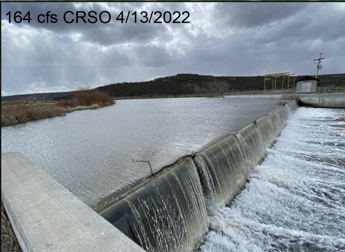
There were many very interesting presentations at the annual Deschutes Fisheries Workshop last week which I will be diving into soon. One of them was on downstream smolt migration and survival in the Crooked River in 2022. Last Wednesday Tim Porter, ODFW Deschutes District Assistant Fish Biologist, gave one of those presentations to Central Oregon Flyfishers where I was able to get many questions answered. In short, the presentation was alarming. Keep reading for the presentation and a discussion.
Last spring (2022) ODFW radio tagged 50 steelhead and 50 chinook smolts prior to their acclimation and release at the Deschutes Land Trust’s Ochoco Creek Preserve. The purpose was to track their migration down to Lake Billy Chinook in a low water year. Also, there was no “pulse flow” in the Crooked River last year. These 100 fish were a small subset of the total number of smolts released into the Crooked River and its tributaries. Many of these other fish had PIT tags inserted that helped estimate the total capture rate at the SWW. In short, the capture rate was extremely disappointing.
The bottom line is that in 2022 only 13% of all chinook and 1.5% of all steelhead smolts released in the Crooked River and its tributaries upstream of Opal Springs made it to the Selective Water Withdrawal tower on Lake Billy Chinook. Of the 100 radio tagged fish, only 2 chinook smolts were detected in the Crooked River arm of LBC. Only a single steelhead was detected downstream of Smith Rocks and it was not detected at Opal Springs or the Crooked River arm.
ODFW cautions that there are many variables at play here. Radio tags are not always detected for a variety of reasons. For example, batteries can fail or expire or the station may be off line or malfunction. Nevertheless, the 13% capture rate for chinook and 1.5% for steelhead smolts at the SWW are good estimates.
ODFW performed the study to determine where significant downstream migration barriers may exist in low flow years. Data from a single year is not enough to make any firm conclusions, but it certainly is concerning. It is also important to note that ODFW has no control over water releases from Bowman Dam into the Crooked River. Those are controlled by Ochoco Irrigation District, the Bureau of Reclamation, and the US Fish & Wildlife Service.
One problem appears to be the Crooked River Central Diversion dam which services a small irrigation district below Prineville. It is about 2 miles downstream from where the smolts were released. Only 20 of the chinook smolts and a single steelhead smolt were detected downstream of the dam. There is a fish ladder at the dam, but it is primarily intended to move fish up the river not down, especially when there is little attraction flow that would help downstream moving fish find the ladder.
Downstream migrating smolts primarily pass over the dam which is not an issue when there is more water, but in low water they will be slammed into a concrete footing at the base of the dam. See the photo above. Also, the pool above the dam was very slow moving last spring, allowing for easy predation, especially by otters. Finally, in that pool there is a withdrawal into an irrigation ditch which may not have adequate screening to block fish.
There are also areas below the dam where boulder fields likely impeded migration. Evidence of otter predation was observed in these areas.
There are many unanswered questions, and further study needs to be done, study that is not currently funded. The bottom line, however, is that 2022 saw extremely low smolt capture rates at the SWW from the Crooked River. ODFW knew that Crooked River downstream migration would be an issue last year and released more smolts in other areas, but adult returns in 2-3 years could nevertheless be impacted.
